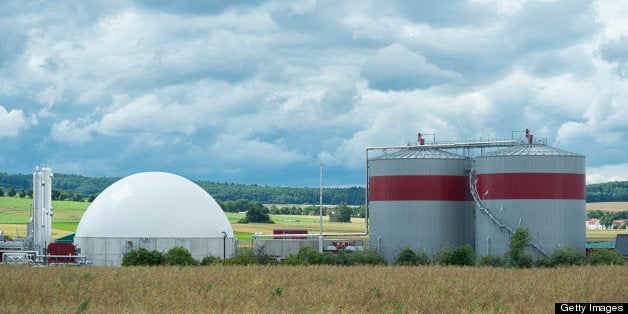
Today I introduce you to 1250now.org. Now, no one should be surprised that we're passing 400 parts per million carbon dioxide. The surprising part is that we're getting pretty far along without any real agreements to deal with the problem. And, for many people, more surprising still will be this: In our worsening position, as the early effects of warming begin to be felt, and are already becoming critical around the planet's polar regions, there must be both a long-term strategy and, now, a separate near-term one -- and this near-term strategy can have almost nothing to do with carbon dioxide.
For the long-term strategy, 400ppm carbon dioxide is the midpoint between two views of the future -- the conventional "450 future," which was assumed to correspond to a 2 degrees Celsius rise above pre-industrial temperature, hopefully forming a guardrail against 'dangerous interference' with the climate, and a "350 future," corresponding to a rise of about 1.5 degrees Celsius above pre-industrial, first espoused by climate scientist James Hansen, then popularized by Bill McKibben and his 350.org, and since embraced by more and more major figures in science and politics. Recent research and climate events suggest Hansen's 350 was correct, and the 450 view was mistaken, but right now we aren't headed toward either, and, given the current fossil fuel bonanza, might even find ourselves surpassing not 450 but 500ppm in a few decades if something isn't done. This is a monumental struggle, and must be fought tooth, nail, blood, guts, whatever it takes.
It will take cool heads to prevail in a heating world, however, and one quick path to disaster could be that, too caught up in the intensity of this struggle, we ignore the necessity of the near-term strategy as well. So I would like to introduce you to 1250, a new group I've been involved in forming. It has recently come online at 1250now.org, and has launched a petition you can sign and circulate. 1250 does not deal with the long-term stabilization of carbon dioxide, and is focused on the need to act quickly on non-carbon dioxide factors to help near-term climate, making it complementary to 350.org's long-term carbon dioxide focus. 1250 stands for 1250 parts per billion methane, a practical interim methane target, but the group is also concerned with other things such as black carbon emissions, and an Arctic-wide preservation program involving direct environmental restoration projects must also now be part of it. The 350 goal for carbon dioxide will be difficult to achieve this century (unless geoengineering is used), but there is a good chance that 1250ppb methane could be reached, with a global-scale effort, in less than three decades. One important international study has shown that reductions of methane and black carbon together can cut projected warming between now and 2050 in half.
Peter Wadhams, a leading Arctic sea ice scientist who is part of 1250, projects that summer sea ice is likely to drop to near zero coverage within just a few years. Reductions in carbon dioxide emissions, absolutely essential to ensure long-term climate stability, act too slowly to moderate warming over the next few decades. So if we are going to address this Arctic crisis, or the superstorms, droughts, floods, tornadoes and crop failures of next year, of five years from now, of a decade from now, or even of twenty or thirty years from now, our only tools for doing so are 1) reductions of these short-lived factors, and 2) climate engineering. It is hard to swallow, and both counterintuitive and disconcerting to contemplate, that all the hoped-for renewable energy from solar and wind, and all the closures of those dirty coal plants, so vital to the future of society, will make little difference until we are almost gone or have passed, yet a set of rather humdrum-sounding cuts of methane, black carbon, HFCs, and even a non-greenhouse gas like carbon monoxide, could, taken together, have substantial and rapid impacts on warming for the remainder of our lives.
We might only have a few years left to decide if we really want to pursue 1250, however: to give a rough idea of this, while current natural Arctic methane emissions are highly uncertain, if we leave the Arctic to melt, and the summer sea ice indeed plummets in the next few years, leading to chronic methane releases reaching the atmosphere there increasing, let's say, three or fourfold, then assuming high-end current release estimates, the best we could do through anthropogenic methane cuts from that point on would likely be just to tread water, holding methane steady, barely lowering its abundance at all! Thus the window on making this 1250 approach highly effective might be rapidly closing, and after this, little else will be left to secure near-term climate except geoengineering. Environmental groups opposed to geoengineering should be buzzing about 1250's prescriptions like bees around honeysuckle.
Just as Hansen started the 350 movement, 1250's approach comes from him as well -- Hansen originally called it his "alternative scenario" for 21st century warming, and it has recently been updated in the work of Drew Shindell and others, embodied with at least the framework of an institution to enact it, initiated by Hillary Clinton. What we really need right now is to reconfigure Hansen's alternative scenario into far less time -- far less, even, than the updated Shindell version. In order to achieve this, we will likely need to restructure the economic fundamentals of what Clinton and others like Robert Watson (former Chair of the IPCC) have started. That won't happen without much more public awareness and pressure.
I saw Hansen last September, on the very day that the lowest recorded sea ice extent was announced. He told me that he really wanted to get back to talking about his "alternative scenario," but just needed to feel sure that something would get done about carbon dioxide. Until Hansen gets the chance to start talking about it again, you can in the meantime help him, and the 1250 goal, by signing and circulating this petition.
